Description and mechanics of folds
Lecture index: Description
of single folded surfaces. / Description
of mutliple folded surfaces and fold style. / Kinematic
analysis of folds in cross section. / Fold
formation mechanisms. /
Readings:
- Chapt. 11 in Fossen, Structural Geology
- Features of folded rocks p. 77-101 in Maley,
T. S., 1994, Field Geology Illustrated, Mineral Land Publications,
Boise, Idaho. This is beautifully illustrated book, which educates/trains
the eye.
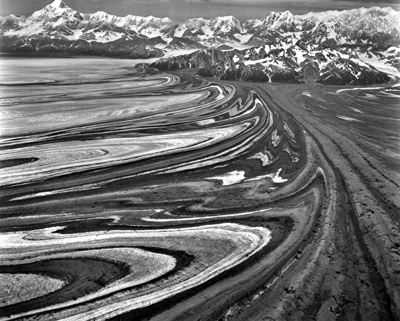 List
of key terms:
List
of key terms:
- fold types: cylindrical, concentric, conical,
irregular, composite
- fold crest, fold hinge, fold axis, fold limbs
- axial plane, axial surface, axial trace
- vergence
- fold scale
- interlimb angle
- fold curvature - rounded to chevron, cuspate
- enveloping surfaces and wave characteristics
- antiform, anticline, synform, and syncline
- monoclines and structural terraces
- parallel vs. similar folds
- parasitic or secondary folds
- fold interference patterns
- fold transposition
- flexural slip
- buckle folds
- flow or viscous folds
- layer parallel compression
The adjacent photo is of folds evident in
ice and debris material in Malaspina glacier, St Elias Mountains
of Alaska. The folds reflect deformation, flowage in the ice.
Another factor in the appearance here is that this is
not a orthogonal cross section view, but a very oblique slice
provided by a melting surface, and thus layer thicknesses are
not true layer thicknesses (measured perpendicular to the layer boundaries). Indeed, given that moraine material
is often of a stripe, character, the geometry is not simply that
of folded parallel layers. Photo source: http://libraryphoto.cr.usgs.gov/cgi-bin/show_picture.cgi?ID=ID.%20U.S.%20Geological%20Survey%20425
.
Description of single folded surfaces
A common assumption is that layers start out
as planar and horizontal.. This is a good working assumption
for many strata. When might it not be a good assumption? We
will start out exploring how to describe the character of just
a single folded surface. Such a surface might be represented by
a surface contour map.
 cylindrical geometry:
cylindrical geometry:
- idealized fold surface that can be reconstructed
by rigid translation of a line through space. That line
is the fold axis, an important symmetry element.
- serial cross sections perpendicular to fold axes are
identical.
- concentric
is a special case, where fold axis follows part of circular arc.
- many folds approximately cylindrical.
- stereonet signature - great circle girdle
of poles to the folded layer on stereonet.
- planar strain a possible approximation.
- can model fold surfaces in Excel. Link to short description of modeling surfaces in Excel. Link to Excel sheet that models some simple folded surfaces.
conical geometry:
- fold surface reconstructed by rotating
one line about another.
- cone axis and apical angle are important descriptors.
- change in serial cross sections (smaller
amplitude).
- these folds die out along their length -
nonplanar strain.
- often a good approximation of the end of
doubly plunging fold.
- stereonet signature - small circle girdle
of poles on a stereonet.
irregular geometry:
- what it sounds like (a wrinkled blanket is
a good example).
- occurs in migmatitic rocks, a chaotic system?
composite geometry:
e.g. a cylindrical middle portion and conical ends.
More complex patterns occur due to refolding
and the variety of interference patterns that can develop. The Excel sheet above can model some simple examples.
Geometric descriptors for cylindrical folds:
- fold crest,
fold hinge, and fold axis. The first two are material
lines with a specific position in the folded surface.
- enveloping surfaces. Can describe their orientation.
- fold limbs versus fold hinge.
For some folds the distinction is simpler, and for some one can't separate. The hinge can be an area of concentrated strain.
- vergence =
fold asymmetry, related to vorticity, and in some situations
to simple shear sense. Inclination of axial trace to enveloping
surfaces short vs. long limb asymmetry.
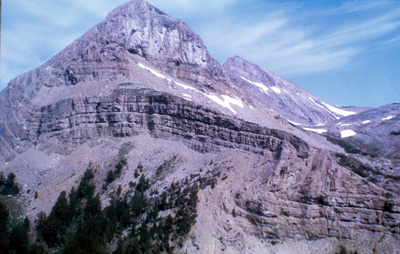 Folds in carbonate strata in Montana
showing a clear vergence (limb asymmetry). View is northward. What direction is the vergence? Photo source: http://libraryphoto.cr.usgs.gov/cgi-bin/show_picture.cgi?ID=ID.%20Mudge,%20M.R.%20369ct
.
Folds in carbonate strata in Montana
showing a clear vergence (limb asymmetry). View is northward. What direction is the vergence? Photo source: http://libraryphoto.cr.usgs.gov/cgi-bin/show_picture.cgi?ID=ID.%20Mudge,%20M.R.%20369ct
.
Description according to size (terminology works with
other structures):
- microscopic.
- mesoscopic-megascopic: middle-visible scale; can be seen in its entirety by the naked eye.
- macroscopic: "
covering bodies to large or too poorly exposed to be examined
directly in their entirety" p. 16 Turner and Weiss.
- dependent on perspective, and on type of
outcrops.
- preferred alternative: thin section scale, hand
specimen scale, outcrop scale, and map scale.
Description according to tightness or interlimb
angle:
- Ramsey classification, used in literature:
- 180-120 = gentle.
- 120-70 = open.
- 70-30 = closed.
- 30-0 = tight.
- 0 or parallel limbs - isoclinal.
- why not just give interlimb angle?
- significance? - can give some type of information
about degree of strain and layer parallel shortening.
Description according to profile curvature:
- rounded.
- angular.
- chevron.
- cuspate.
- conjugate fold
= box fold, multiple hinges and axial planes.
- mathematical - sine functions, harmonics
and successive approximations. Provides complete description,
but not easily accessible, and quite time consuming.
- wavelength,
amplitude, geometry of enveloping surfaces.
- mechanical significance of above?
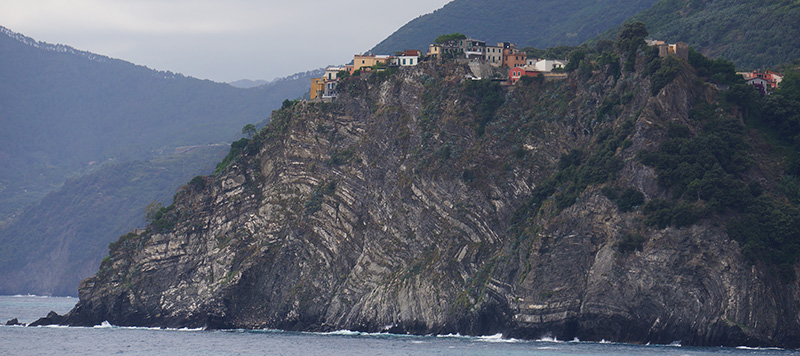
This photo is of a large conjugate or box fold structure with one of the 5 small fishing villages and popular tourist destinations of the Italian west coast, an area known as Cingue Terre, perched above. The strata are largely turbidites, and the deformation is related to a complex tectonic evolution that includes subduction. Note how the fold form changes as you ascend or descend in the sequence, a trait characteristic of parallel fold geometry (described below). These structures are part of the Northern Appenines, with Mesozoic strata deformed during the Cretaceous. More information on the geology of this area can be found at: www.isprambiente.gov.it/files/pubblicazioni/.../memorie/.../d09.pdf
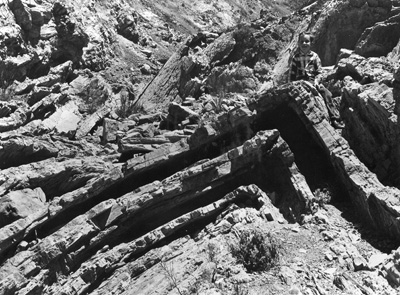 Photo of fold from USGS in Cretaceous
strata of Chile. What term might you use for the geometery of
this fold? Photo source: http://libraryphoto.cr.usgs.gov/cgi-bin/show_picture.cgi?ID=ID.%20Segerstrom,%20K.%20563
.
Photo of fold from USGS in Cretaceous
strata of Chile. What term might you use for the geometery of
this fold? Photo source: http://libraryphoto.cr.usgs.gov/cgi-bin/show_picture.cgi?ID=ID.%20Segerstrom,%20K.%20563
.
Description according to orientation and
age relationships:
- antiform vs. synform.
- anticline vs. syncline.
- antiformal synclines
and synformal syncline.
- degree of plunge, and degree of axial plane
inclination - Fleuty diagram.
- overturned folds = those with an overturned
limb.
- monoclines
and structural terrace.
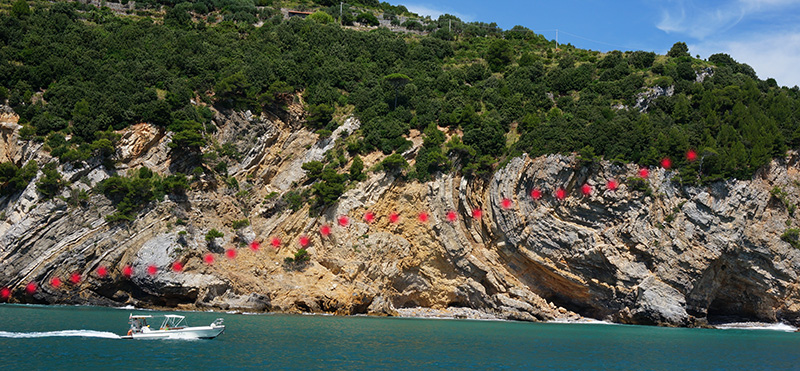
This is a cliff side along an island just south of Porto Venere in Italy that provides a natural cross section of a large fold structure evident in a marble rich sequence (the Porotoro marbles). The red dotted line traces the approximate position of the axial plane as defined by hinges. Naturally, one of the two limbs must be overturned and with a close to horizontal axial plane this fold can also be considered recumbant. Fold nappes are known from this area. .
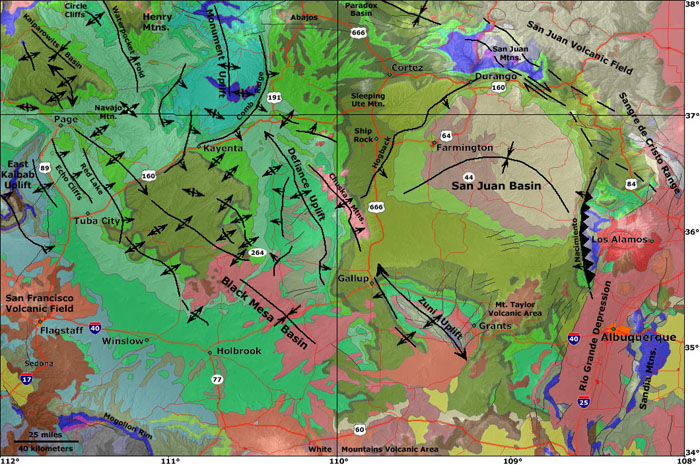
Image showing map traces of large scale anticlines, synclines and monoclines for the 4-corners area of the U.S.. The monoclines only have an arrow on one side. Note how the defiance Uplift changes along strike. Also note the different directions the fold features are oriented at. Image source: http://geomaps.wr.usgs.gov/navajo/4corners/maps/geology_structure.html .
Description of mutliple folded surfaces and fold style
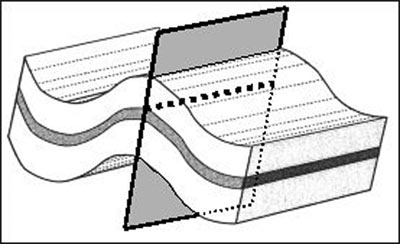 axial plane: the
limb bisector plane for simple geometries.
axial plane: the
limb bisector plane for simple geometries.
axial surface: the
plane formed by the sum of all the fold hinge lines. Better descriptor
to use, can have distinct strain significance.
The image to the right depicts the axial plance for a simple fold. the dashed heavy line represents the fold hinge line. All the hinge lines together define the axial plane or axial surface (if it is not a planar surface). Image source USGS site: http://pubs.usgs.gov/of/2005/1428/mcinerney/
axial trace on surface: the line formed by the intersection of the axial surface
and the earth's surface; i.e. the map trace of the axial surface.
parallel folds
:
- also known as concentric folds.
- thickness perpendicular to layer boundaries
is maintained.
- Busk reconstruction method - one way of reconstructing fold profile geometries.
- disharmonic character - profile geometry changes along axial plane.
- YouTube video of disharmonic folds generated in a stack of toilet paper (german variety) - http://www.youtube.com/watch?v=Ya9TBUfLQnI .

These are folds in Cretaceous strata exposed at Ernst Tinaja in Big Bend National Park, a very popular stop for geologists. They show the disharmonic geometry and maintenance of bedding-perpendicular thickness that characterize a paralel fold style.
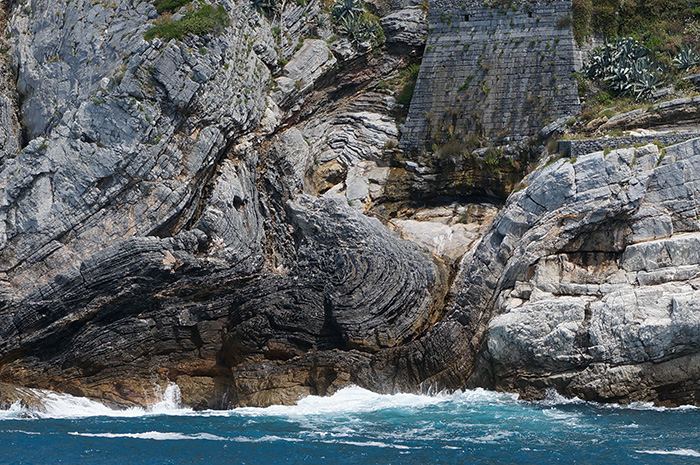
Fold in marbles from cliffside of Porto Venere Regional Nature Park (same locality and geologic context as two photos above). Here one can see a disharmonic fold sandwiched between two slip zones both of which are partially bedding parallel. Disharmonic folds are associated with slip along layering and often with detachments, as they are here, and one possibility is that this fold structure is acting as a transfer zone where slip is 'climbing' from one slip horizon to another. Towards the right one can also see the thicker grey carbonate layer truncated. There is fault herewith the layering on the left side parallel to the fault, and the layering on the right side truncated. If you trace that fault upward you see that it bends so that it is parallel to the layering. This structural pattern is not uncommon. As you will see layer parallel slip is a common component in some types of folds and faults.
similar folds:
- t is constant for a given layer as measured
parallel to the axial plane. Fold hinges appear thickened relative
to thinned limbs.
- harmonic, ideally, different layers show
the same profile geometry.

Schematic diagrams showing these two end-member fold geometries. As you might suspect, the direction in which layer thickness is maintained in the similar fold geometry to the right has kinematic significance.
Composite fold forms are the most common,
with some layers retaining layer thickness, and others not. This
is due to differences in rock competency and anistropy, which causes different lithologies to fold by different mechanisms.
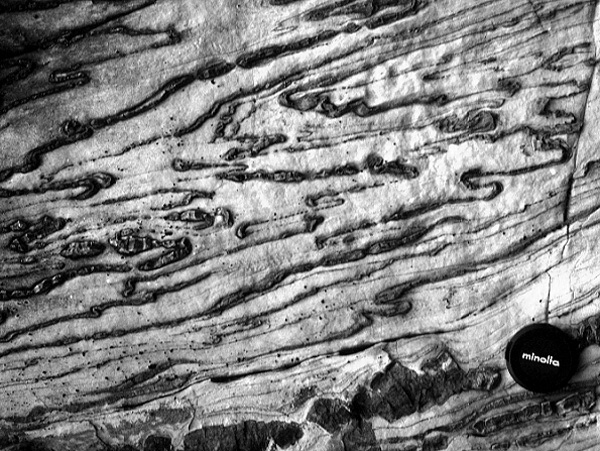 Folds of chert layers in the marble
matrix of the Bruce 'limestone' from the Precambrian Huronian sequence above Lake Huron in Canada. Note
how it is difficult to trace for certain the delicately fold layers
across the photo. One might describe the layering as show incipient
or mild transposition. Also doe the brittle behavior evident in
the thicker cher layer near the base. See below for further explanation.
Folds of chert layers in the marble
matrix of the Bruce 'limestone' from the Precambrian Huronian sequence above Lake Huron in Canada. Note
how it is difficult to trace for certain the delicately fold layers
across the photo. One might describe the layering as show incipient
or mild transposition. Also doe the brittle behavior evident in
the thicker cher layer near the base. See below for further explanation.
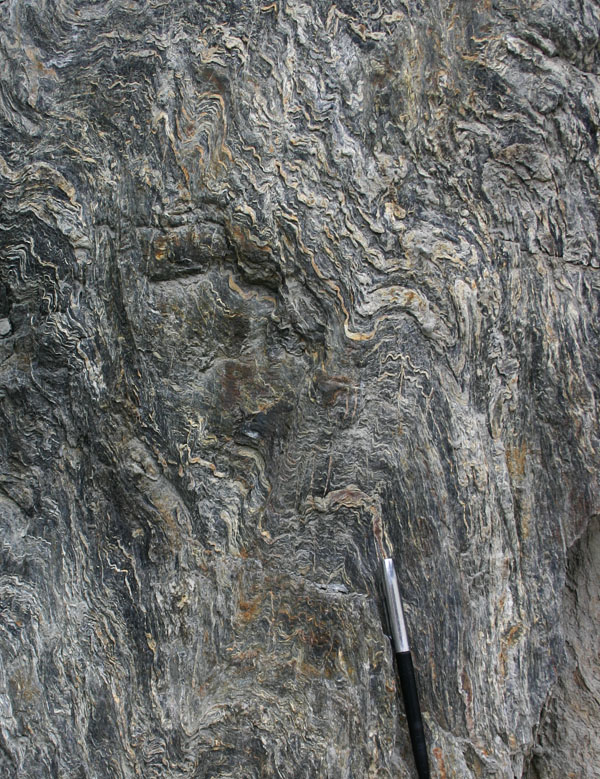 fold transposition:
fold transposition:
- a compositional layering that was originally
bedding, but where intense deformation has obliterated stratigraphic
relationships and continuity so that the layering reflects a deformation fabric.
- common in marbles, quartzites, and mica-
rich metasediments.
- View to right of intensely folded and deformed metasediments from near Valdez, Alaska. Many of the lenticular white layers are veins. Look closely and you can find floating fold hinges and other indications of transposition. There is also a subvertical (parallel to pen) spaced foliation surface that is axial planar to some of the later folds, marked by thin white segregations, clearly indicating this rock has suffered polyphase deformation.
- transposition recognition criteria:
- floating, isoclinal fold hinges - intrafolial
folds.
- cleavage and/or foliation parallel to bedding.
- extreme flattening, or elongation of strain
markers.
- isolated boudins or pods of more competent
material.
- drag folds of opposite vergence in close
proximity.
- reversals of younging criteria in a short
distance.
- layers discontinuous as you trace them.
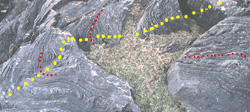
If you examine the detailed
version of this photograph to the left from the NW coast of Ireland (click
on the image to see a larger version) you can see that the axial
traces of an earlier fold phase (some shown with red dots) are
folded around a later phase fold with its approximate axial trace
shown with yellow dots. These are Dalradian marbles that have
seen complex polphase deformation including a major Caledonian
phase.
polyphase deformation and fold interference
patterns.
- e.g. cross folding and domes and basins and
saddles: exact geometry a function of wavelength and amplitudes
of two fold phases.
- short YouTube video demonstrating one simple possibility - http://www.youtube.com/watch?v=fBLf2tt8isM
, and a portal to a number of possibilities - http://www.youtube.com/watch?v=4e7gxpNP6EI .
- coaxial folding - potentially part of one
phase, as a continuum. Rotation suggests a significant simple
shear component to the deformation history.
- noncoaxial folding - infinite possibilities.
- sheath folds:
- how to detect?
- girdle pattern of fold axes on stereonet
(folding of an earlier line). Great circle is shear plane. Associated
with significant non-planar strain.
- 30 minute extended lecture on sheath folds - http://www.youtube.com/watch?v=t2niBJuDT5A .
- example in Dalradian rocks of NW Ireland.
Kinematic analysis of folds (and faults) in cross section
Basic assumptions for simple balanced cross section analysis:
- orthogonal cross-section.
- no out of the plane (cross section plane)
movements (plane strain).
- parallel fold geometry helps.
- original geometry must be fairly well constrained.
Shallow crustal level fold and thrust belts
often meet these requirements to a good enough approximation.
Sinuous bed method:
- amount of shortening = original length -
present map width.
- percentage of shortening = 1 - present length/original
length.
- good idea to do several horizons at different
stratigraphic levels in cross section.
Equal area method:
- can take into account unit internal deformation.
- need original stratigraphic thickness.
- present area / original strat. thickness
= original length; then stick into above.
- calculation to depth of basal decollement
(see overhead) t = A / (la - lc).
Typical amounts of shortening in fold-and-thrust
belts = 10s to 100s of km.

Example of USGS balanced cross section. Found at http://en.wikipedia.org/wiki/File:USGS_Balanced_Section.png .
Fold formation mechanisms
Flexural slip folds:
- telephone book model.
- associated with layer parallel compression.
- produces parallel fold geometries.
- layers have internal strength and resist internal
strain, whereas the boundaries between layers are low strength.
- small inhomogeneties can cause parasitic
folds to develop.
- bedding parallel striae or slickensides can
develop.
- very common in fold-thrust belts.
Fault propagation folds:
- also called trishear folds.
- cored by a fault, whose tip propagates into
the overlying fold with time.
- quantitative models by Allmendinger showing
trishear fold evolution.
- YouTube video showing development of compressional, listric tri-shear zone and other fold/fault types- http://www.geo.cornell.edu/geology/faculty/RWA/movies/ .
- slip on discrete fault becomes distributed
to slip on bedding and smaller scale faults.
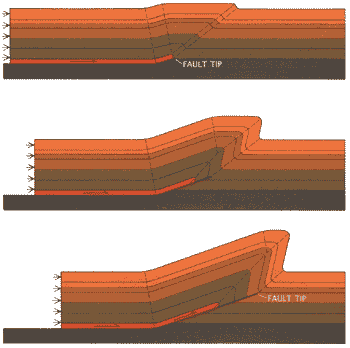
Diagram from USGS site - http://quake.usgs.gov/research/deformation/modeling/papers/scientam/scientam.html
- showing development of fault propagation fold. Such folds
can be important in seismic risk assessment, because the fold
reflects a hidden earthquake generating fault hidden at depth.
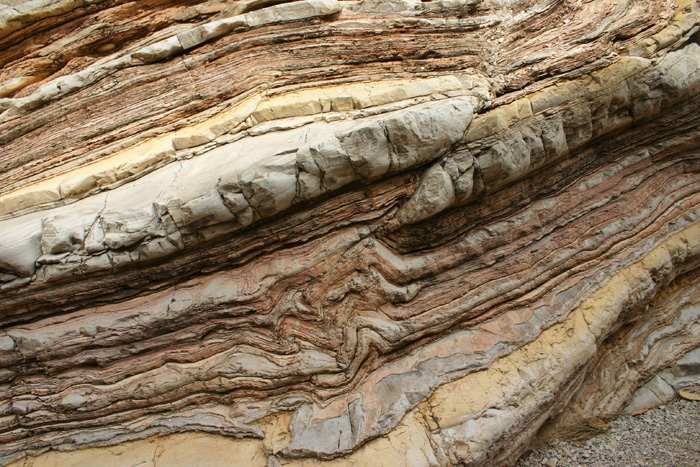
These are deformed Cretaceous strata from Ernst Tinaja in Big Bend National Park. Note how the thicker limestone layer is brittlely faulted. However, as the fault is traced down into the underlying thinner bedded strata is disappears in a complex of small folds. This is not accidental. The folding and faulting are linked, and this is an example of a tri-shear zone, where slip concentrated on one surface or zone gets distributed over an area.
Fault-bend folds:
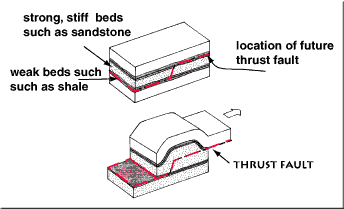 USGS block diagram of fault-bend
fold developing above a thrust ramp. Source of image: http://geology.wr.usgs.gov/parks/noca/sb8methrx.html.
USGS block diagram of fault-bend
fold developing above a thrust ramp. Source of image: http://geology.wr.usgs.gov/parks/noca/sb8methrx.html.
Buckle folds:
- single layer situation where a more competent
layer is surrounded by an incompetent material. The former
is free to form buckle folds that have a parallel character,
while the former will show another shape.
- Biot (1957) -- correspondence principle between
elastic and viscoelastic materials (Newtonian viscosity), looks
at stress-strain relationships in buckled layer.
- Ramberg (1959) -- approaches problem as one
of fluid dynamics - particular function which satisfies both
the biharmonic equation of a stream function and boundary conditions
around a buckled layer.
- Both develop idea of dominant wavelength.
Mathematically valid for small % of strain, but then have inheritance principle;
- wd
= 2 t ^3 ( µ1
/ 6µ2 ) where wd is dominant wavelength, t is layer thickness,
and µ1 and µ2 are the viscosities of the dominant
layer and surrounding medium respectively.
- note that deviatoric stress plays no direct
role.
- viscosity contrast, if < 5 get pure shortening.
- too high deviatoric stress get brittle failure,
too low pure shortening.
- see this with ptygmatic folds in some outcrops;
average wd/t ratio of 27.
- are folds with ratio around 5-7; possibly
due to non-Newtonian viscosity.
- extrados and intrados of a beam -
features that would indicate buckling.
- video of buckle fold demonstration.
Differential simple shear folds:
- card deck model.
- layer being folded is passive marker, and
not a strong unit.
- similar fold forms, problems with vergence,
and sense of shear.
- common in mid-crustal depths where good metamorphic
anisotropies have developed, where deformation is often concurrent
with metamorphism.
- expected in mylonite zones.
- video of sandbox run that produces shear folds.
Flow or viscous folds:
- differ from simple shear folds in the number
of possible shear planes that can operate. Van Mises criteria
- 4 independent slip surfaces allow deformation to any shape.
- these types of folds are common in soft-sediment deformation and migmatitic
terranes.
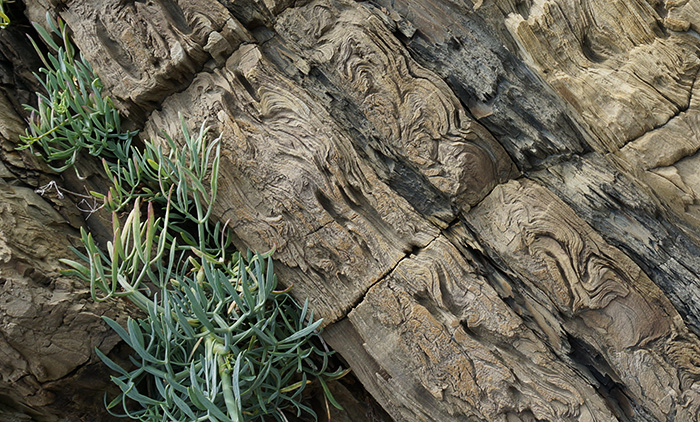
Note the soft sediment folds in these tilted turbidite beds exposed in the Cingue Terra cliffs of Italy (see some of the photo captions above for more context). A careful look shows extreme changes in bedding thickness, strongly curved axial planar surfaces and fold axes (e.g. in upper left) and a general chaotic style typical of flow folds. Such soft sediment deformation is common in turbidites and accretionary wedge sedments.

Pollen on top of portion of a small lake in the Norwegian forest. The complex and changing flow pattern of the water deforms linear concentrations of the floating pollen into counter-top patterns. Patterns of gneissic banding in rocks can look much the same.
Accentuation of fold form by pure shear - e.g. by pressure solution, or as we will see with
cleavage formation (next lecture).
Copyright Harmon D. Maher Jr., This may be
used for non-profit educational purposes as long as proper attribution
is given. Otherwise, please contact me. Thank you.
 List
of key terms:
List
of key terms: List
of key terms:
List
of key terms: cylindrical geometry:
cylindrical geometry:




 axial plane: the
limb bisector plane for simple geometries.
axial plane: the
limb bisector plane for simple geometries.



 fold transposition:
fold transposition:




